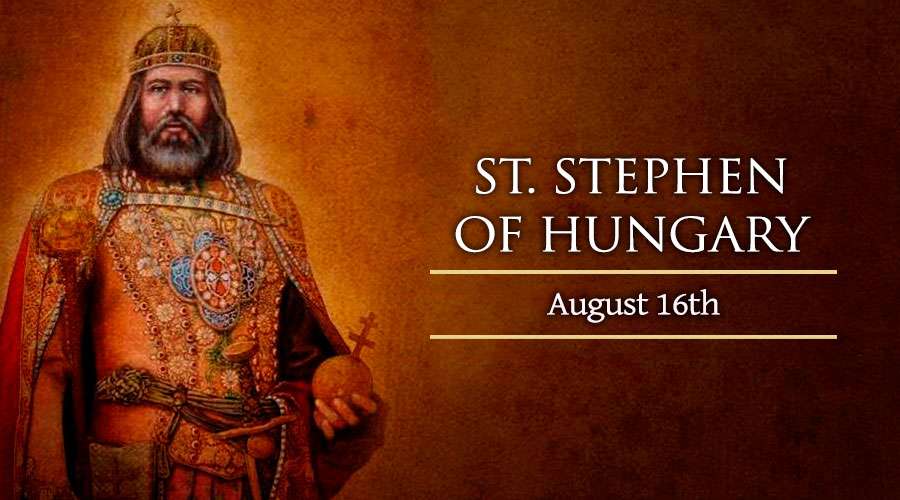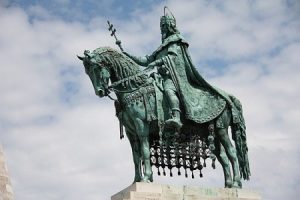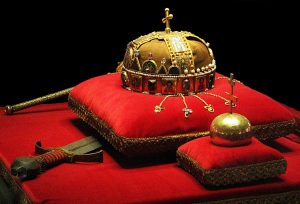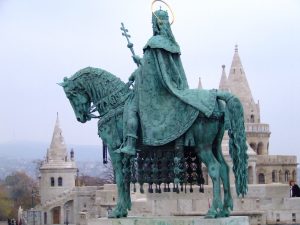
St. Stephen of Hungary was a husband and father, and a great reforming king. Given the birth name Vajk, he was born to the leader of the Magyars, Grand Prince Geza, and Charlotte, his wife circa 975 at Esztergom built aside the Danube River. The Magyars were a nomadic people from the east and conquered a large area east of the Danube. A warlike people, they gradually settled there and assimilated somewhat into the more established societies that were remnants of the Holy Roman and Byzantine Empires. Having received missionaries from both the Latin and Byzantine traditions, there were some conversions among them.
CONVERSION FROM PAGANISM
A most notable conversion was that of Grand Prince Geza, baptized in 985 by [St.] Adalbert, Bishop of Prague. Also baptized with his father was Vajk, then age ten, and who took the Christian name Stephen. While Geza did not take his Baptism very seriously, retaining many of his pagan practices, young Stephen took his Baptism quite seriously. Stephen took the learned Adalbert as his teacher and mentor, and intended to not become a warlord like his father, and to change the Magyars into a Christian kingdom. He married Gisela, the sister of Duke Henry III of Bavaria.
In 995, Geza was old and ill, and he named his son to succeed him. When Geza died in 997, Stephen succeeded him, and endured a series of wars against rivals for power. He was resolved to unify his people and to expand Christianity throughout the kingdom, although he had not yet been officially declared king.

ASCENSION TO KINGSHIP
In 1000, he sent a delegation to Rome to request to be declared an Apostolic King. Pope Sylvester agreed and sent back the official declaration and a beautiful crown. This title was an honorary one bestowed due to Stephen’s effort to propagate a Christian kingdom. Stephen established a hierarchy which would be necessary for an orderly reign, and named [St.] Astrik Hungary’s first ever archbishop. The naming of bishops by medieval kings was a common practice. King Stephen organized sees, or the principal cities of each regional church (diocese). He had churches built, using taxes for their construction and the support of clergy. He completed the building of a monastery under the patronage of St. Martin, the great pioneer of western monasticism, born at Pannonia nearly seven hundred years earlier. King Stephen also established a legal/moral system similar to a constitution. His most notable reform was the requirement for all adults who were not clergy or vowed religious to be married. To twenty first century sensibilities, which so cherish personal freedoms, this may seem excessive. It must be remembered that stable marriages are necessary for a civilized society, not just for the handing down of property, but also for the protection of women and children from exploitation and abandonment. He also established private ownership, a concept not previously known in Magyar society. He made murder, theft, adultery and blasphemy illegal, and established a court system and law enforcement. King Stephen was widely known to be very generous towards the poor. He often disguised himself in order to walk about giving money to poor people without being recognized. Even after being beaten and robbed, he continued such outings. In an effort to stamp out pagan goddess worship, he had Szekesfehervar Cathedral, built between 1010 and 1020, dedicated to the Assumption of the Virgin Mary.
AN UNEXPECTED TRAGEDY
Stephen and Gisela’s son, Emeric, was groomed from childhood by his father to become a wise ruler to succeed him. As a young adult who had proved himself in battle, Emeric was tragically killed in a hunting accident, devastating his father. Before his death, Stephen named his nephew as his successor, avoiding leaving the kingdom in the hands of his foolish and still-pagan cousin, who unsuccessfully attempted an assassination against Stephen in his sickbed. Stephen died August 15, 1038, thirty-eight years to the day after his coronation. He was buried next to Emeric, who had since been beatified, at Szekesfehervar. Numerous miracles were reported by those who venerated them there. Stephen’s remains were later transferred to what is now St. Matthias Church in Budapest. The original Szekesfehervar Cathedral was destroyed by fire in 1601, after having been desecrated by an Islamic Turk invasion in 1543.
FOUNDER OF HUNGARY

St. Stephen of Hungary did everything in his power to transform his barbarous subjects into a humane, civilized people. While the kings who followed him nullified many of his reforms, Stephen is known as the founder of Hungary as an independent nation. It is important to understand his apparent “heavy-handedness” in its historical context as a means to establish civility and order in line with the perennial teachings of the Church. Stephen was canonized with his son Emeric in 1083. He is the patron of Hungary, whose people still call upon his intercession during times of crisis as recently as the decades of Communist oppression. The magnificent crown which was sent to him from the Pope was used as the official crown of the Kings of Hungary until the monarchy ended in 1916. It was found in Austria by American Allied troops in1945, and kept safe at Fort Knox, Kentucky, until being returned to Hungary in 1978. St. Stephen’s feast day is August 16.

